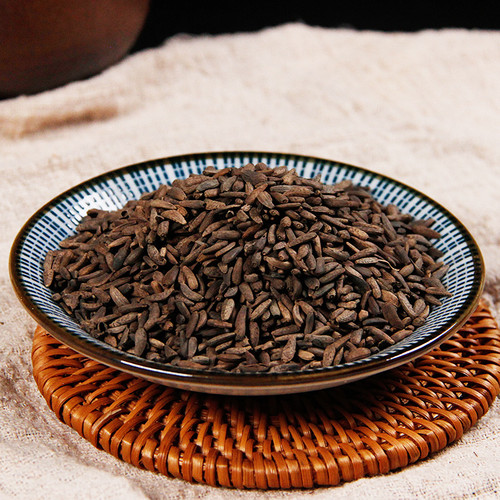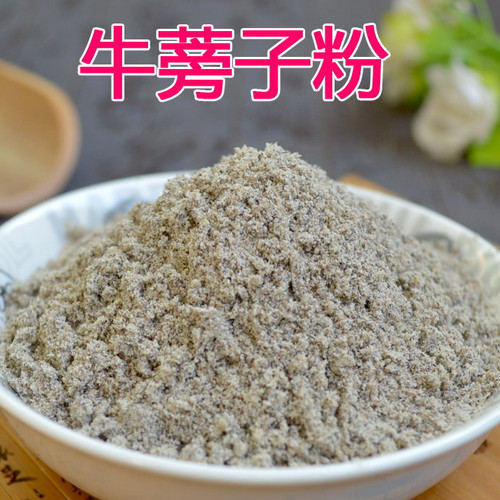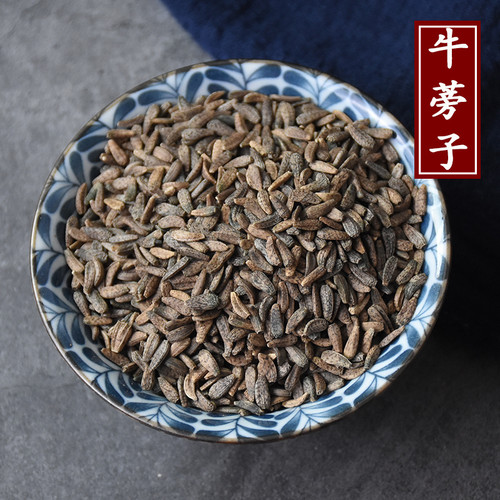Product Overview
Parts used: Dried ripe fruit
TCM category: Cool/Acrid herbs that release the Exterior
TCM nature: Cold
TCM taste(s): Bitter Pungent
Meridian affinity: Stomach Lung
Scientific name: Arctium lappa
Other names: Gobō, Edible burdock, Lappa, Beggar's buttons, Thorny burr, Happy major
Use of greater burdock fruits (Niu Bang Zi) in TCM
Please note that you should never self-prescribe TCM ingredients. A TCM ingredient is almost never eaten on its own but as part of a formula containing several ingredients that act together. Please consult a professional TCM practitionner, they will be best able to guide you.
Preparation: After harvesting, dry the inflorescences and, once fully dried, shake to remove the fruits and seeds. Clean to remove any impurities.
Dosage: 6-12g
Main actions according to TCM*: Relieves the Exterior and disperses Heat. Allows the release of toxicity from the surface and clears Heat. Reduces swelling and clears pathogenic Heat. Lubricates the Intestines. Relieves sore throat.
Primary conditions or symptoms for which greater burdock fruits may be prescribed by TCM doctors*: Coughing Measles Rubella Sore throat Mumps Erysipelas Carbuncles
Contraindications*: Can have a laxative effect. Not indicated for people with a Qi deficiency with diarrhea.
Common TCM formulas in which greater burdock fruits are used*:
For sore throat and hoarse voice combine greater burdock fruits with ningpo figwort roots (Xuan Shen), platycodon roots (Jie Geng) and liquorice (Gan Cao).
For swollen and painful sore throat combine greater burdock fruits with honeysuckle flowers (Jin Yin Hua) and platycodon roots (Jie Geng).
For measles and rashes combine greater burdock fruits with bugbane rhizomes (Sheng Ma), wild mint (Bo He) and kudzu roots (Ge Gen).
For Exterior Wind-Heat with symptoms of headache, colds, sore throat combine greater burdock fruits with wild mint (Bo He), chrysanthemum flowers (Ju Hua) and platycodon roots (Jie Geng).
For severe colds, flu or upper respiratory tract infections combine greater burdock fruits with honeysuckle flowers (Jin Yin Hua), forsythia fruits (Lian Qiao), platycodon roots (Jie Geng), wild mint (Bo He), fermented soybeans (Dan Dou Chi), lophatherum herbs (Dan Zhu Ye), common reed rhizomes (Lu Gen), liquorice (Gan Cao), notopterygium roots (Qiang Huo) and woad roots (Ban Lan Gen).
Key TCM concepts behind greater burdock fruits (Niu Bang Zi)'s properties
In Traditional Chinese Medicine (TCM), greater burdock fruits are plants that belong to the 'Cool/Acrid herbs that release the Exterior' category. Herbs that release the Exterior aim to to treat the early stages of diseases that affect the upper respiratory tract, the eyes, the ears, the nose, the throat or the skin. TCM believes that External diseases such as colds or allergies can only invade the body if the External environment overwhelms our Wei Qi (the TCM version of the immune system). In order to counteract this invasion Cool/Acrid herbs aim to induce sweating by dilating our capillary pores so that they release more sweat. The belief is that this will expel the disease from the body and stop it from invading further.
As suggested by its category greater burdock fruits are plants that are Cold in nature. This means that greater burdock fruits typically help people who have too much "heat" in their body. Balance between Yin and Yang is a key health concept in TCM. Those who have too much heat in their body are said to either have a Yang excess (because Yang is Hot in nature) or a Yin deficiency (Yin is Cold in Nature). Depending on your condition greater burdock fruits can help restore a harmonious balance between Yin and Yang.
Greater burdock fruits also taste Bitter and Pungent. The so-called "five elements" theory in Chinese Medicine states that the taste of TCM ingredients is a key determinant of their action in the body. Bitter ingredients like greater burdock fruits tend to have a cleansing action on the body by clearing heat, drying dampness and promoting elimination via urination or bowel movements. On the other hand Pungent ingredients tend to promote the circulations of Qi and body fluids. That's why for instance someone tends to sweat a lot when they eat spicy/pungent food.
The tastes of ingredients in TCM also determine what organs and meridians they target. As such greater burdock fruits are thought to target the Stomach and the Lung. In TCM the Stomach is responsible for receiving and ripening ingested food and fluids. It is also tasked with descending the digested elements downwards to the Small Intestine. In addition to performing respiration, the Lungs are thought to be a key part of the production chain for Qi and the body fluids that nourish the body.
Use of greater burdock fruits (Niu Bang Zi) as food
Greater burdock fruits are also eaten as food. It is used as an ingredient in dishes such as Gobō salad or Stir-fried Carrot & Burdock Root.






